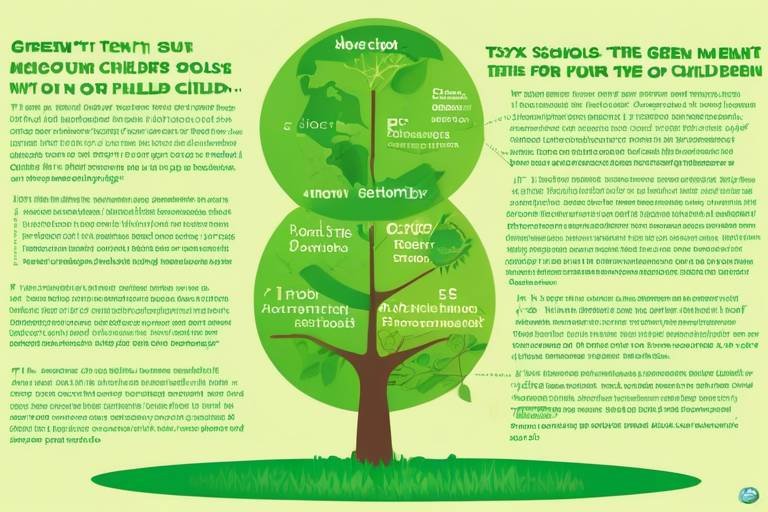The Importance of Reducing Food Waste
Food waste is not just a minor inconvenience; it’s a critical issue that affects our environment, economy, and society as a whole. Imagine walking into your kitchen and throwing away a perfectly good meal. It feels wasteful, right? Yet, this scenario plays out in homes and businesses every single day. The truth is, reducing food waste is essential for creating a sustainable future. By minimizing waste, we can conserve resources, reduce greenhouse gas emissions, and save money. It’s a win-win situation!
Every year, approximately one-third of all food produced globally is wasted. This staggering statistic translates to about 1.3 billion tons of food, which not only represents a significant loss of resources but also contributes to environmental degradation. When food is discarded, it often ends up in landfills, where it decomposes and releases methane, a potent greenhouse gas that exacerbates climate change. If we want to protect our planet, we must take action now to reduce food waste.
But why should you care? Well, think of it this way: reducing food waste is like finding money in your pocket. Every time you save a meal from the trash, you’re not just saving food; you’re also saving the energy, water, and labor that went into producing it. It’s about making smarter choices that benefit both your wallet and the environment. By being more mindful of our consumption habits, we can significantly reduce our ecological footprint.
Moreover, reducing food waste can lead to remarkable economic benefits. Households can save hundreds of dollars each year simply by being more conscious about what they buy and how they store food. If we look at the bigger picture, businesses can also experience substantial savings by minimizing waste in their operations. This economic incentive should motivate individuals and organizations alike to take food waste seriously.
In addition to personal and financial benefits, reducing food waste fosters a sense of community. When individuals come together to tackle this issue, they create a ripple effect that can lead to broader societal changes. Community initiatives, educational programs, and partnerships with local businesses can empower everyone to contribute to a more sustainable future. So, how can we make a difference? The answer lies in understanding the importance of our actions and encouraging others to join the cause.
Ultimately, reducing food waste is about more than just saving money or resources; it’s about creating a culture of sustainability. By embracing practices that minimize waste, we can pave the way for a healthier planet and a more equitable food system. Let’s take the first step together and commit to making a change—because every little bit counts!
- What are some common causes of food waste? Food waste often occurs due to over-purchasing, improper storage, and misunderstanding food labels.
- How can I reduce food waste at home? Meal planning, proper food storage, and using leftovers creatively are effective strategies.
- What happens to food waste in landfills? Food waste decomposes and produces methane, contributing to greenhouse gas emissions.
- Are there community programs that help reduce food waste? Yes, many communities have initiatives that focus on food recovery and redistribution to those in need.

The Environmental Impact of Food Waste
Food waste is not just an unfortunate byproduct of our daily lives; it is a significant contributor to greenhouse gas emissions. When food is thrown away, it often ends up in landfills where it decomposes anaerobically, producing methane, a gas that is over 25 times more potent than carbon dioxide in terms of its global warming potential. This means that every time we waste food, we are not only wasting the resources that went into producing it but also exacerbating climate change.
To put this into perspective, consider the staggering fact that approximately 1.3 billion tons of food waste are generated globally each year. This waste accounts for about 8-10% of all greenhouse gas emissions. Imagine the impact we could have if we collectively made an effort to reduce this number. It’s like throwing away a slice of our planet's future every time we toss out an uneaten meal!
Moreover, the environmental consequences extend beyond just emissions. The production of food requires vast amounts of water, land, and energy. For instance, it takes around 1,800 gallons of water to produce just one pound of beef. When that beef is wasted, it’s not just the meat that’s lost; it’s all the water, land, and energy that went into raising the cattle, growing the feed, and processing the meat. The ripple effects of food waste touch every aspect of our ecosystems, from soil depletion to biodiversity loss.
Additionally, food waste contributes to the depletion of our natural resources. As we continue to produce food to meet the demands of a growing population, we are simultaneously wasting a significant portion of it. This cycle of overproduction and waste leads to a strain on our planet's resources. The environmental impact of food waste is a complex web that intertwines with issues like deforestation, soil degradation, and water scarcity.
As individuals, we can make a difference. By understanding the environmental impact of our food consumption and waste, we can make informed choices that contribute to a more sustainable future. Here are a few actions we can take:
- Plan meals effectively to avoid over-purchasing.
- Store food properly to extend its shelf life.
- Compost food scraps instead of sending them to landfills.
In conclusion, the environmental impact of food waste is profound and multifaceted. It’s not just about what we throw away; it’s about the resources we squander and the future we jeopardize. By taking small yet meaningful steps, we can collectively reduce food waste and its detrimental effects on our planet.
Q: What are the main causes of food waste?
A: Food waste is primarily caused by over-purchasing, poor meal planning, and lack of awareness about food preservation techniques. Additionally, aesthetic standards set by retailers often lead to perfectly edible food being discarded.
Q: How can I reduce food waste at home?
A: You can reduce food waste by planning your meals, making shopping lists, storing food correctly, and using leftovers creatively. Composting is also a great way to minimize waste.
Q: What are the environmental benefits of reducing food waste?
A: Reducing food waste can significantly decrease greenhouse gas emissions, conserve water and energy, and help protect natural resources. It promotes a more sustainable food system and contributes to combating climate change.

Food waste isn’t just an environmental dilemma; it’s also a significant economic issue that affects households, businesses, and the economy as a whole. When we toss out perfectly good food, we’re essentially throwing away money. In fact, studies have shown that the average family of four loses around $1,500 annually due to food waste. That’s a hefty sum that could be better spent on necessities, savings, or even a family vacation!
But it’s not just families that feel the pinch. Businesses, particularly those in the food industry, also suffer from the consequences of waste. Restaurants, grocery stores, and farms face substantial financial losses due to unsold or spoiled food. According to the U.S. Department of Agriculture (USDA), approximately 30-40% of the food supply in the United States goes to waste. This not only impacts their bottom line but can also lead to higher prices for consumers as businesses attempt to offset their losses.
To put it into perspective, let’s take a look at the broader economic implications. The following table illustrates the staggering costs associated with food waste:
| Category | Estimated Annual Loss |
|---|---|
| Households | $1,500 per family |
| Restaurants | $25 billion |
| Retailers | $20 billion |
| Farmers | $15 billion |
| Total | $61 billion |
This table highlights just how widespread and costly food waste is across various sectors. When you consider that these losses could be redirected into more productive avenues, the urgency to address food waste becomes crystal clear. It's not just about saving money; it's about reallocating resources to benefit society as a whole.
Moreover, the economic ramifications extend beyond immediate financial losses. Food waste has a ripple effect on the economy. For instance, when food is wasted, all the resources used to produce, transport, and store that food are also wasted. This includes water, energy, labor, and land. The cumulative effect of this waste can lead to increased demand for food production, which can drive up prices and contribute to food insecurity for those who need it most.
In essence, reducing food waste is not just a noble cause; it’s a crucial economic strategy. By minimizing waste, households can save money, businesses can improve their profitability, and society can work toward a more sustainable and equitable food system. As we ponder the economic consequences of food waste, it’s essential to recognize that every small action counts. Whether it’s meal planning, proper food storage, or donating surplus food, everyone can play a role in mitigating this pressing issue.
- What are the main causes of food waste? Food waste can occur at various stages, including production, transportation, retail, and consumption. Common causes include over-purchasing, poor storage practices, and lack of awareness about expiration dates.
- How can I reduce food waste at home? Simple strategies include meal planning, proper food storage, and using leftovers creatively. Educating yourself about food preservation techniques can also help.
- What role do businesses play in reducing food waste? Businesses can implement better inventory management, donate surplus food, and engage in community initiatives aimed at reducing overall food waste.

When we dive into the world of food waste statistics, the numbers can be quite startling. Did you know that approximately 1.3 billion tons of food are wasted globally each year? That’s roughly one-third of all food produced for human consumption! This staggering amount not only reflects a significant loss of resources but also highlights the urgent need for change. In fact, if food waste were a country, it would be the third largest emitter of greenhouse gases after the United States and China. This fact alone should make us sit up and take notice.
The impact of food waste is felt not just in environmental terms but also economically. In the United States, it’s estimated that families throw away about $1,500 worth of food each year. This is not just a financial loss; it’s a waste of the labor, water, and energy that went into producing that food. Imagine what could be done with that money if it were saved instead of discarded! It’s a harsh reality that many of us overlook in our daily lives.
Furthermore, food waste occurs at every stage of the supply chain, from farms to retail to our own kitchens. According to the Food and Agriculture Organization (FAO), about 40% of food waste happens at the consumption stage, which means we, as consumers, have a massive role to play in addressing this issue. To put it into perspective, in the UK alone, households waste around 6.6 million tons of food every year, which is equivalent to about £10 billion worth of food! This waste not only affects our wallets but also contributes to the growing problem of landfill overflow and methane emissions.
Here’s a quick breakdown of where food waste typically occurs:
| Stage of Food Supply Chain | Percentage of Food Waste |
|---|---|
| Production | 28% |
| Processing | 10% |
| Distribution | 8% |
| Retail | 5% |
| Consumption | 40% |
These statistics illustrate that while food waste is a global issue, it is also a personal challenge that we can tackle in our own homes. By understanding the scope of food waste, we can begin to change our habits and make more informed choices about how we manage food in our lives. So, why not take a moment to reflect on your own food consumption patterns? Are there areas where you could improve? Every little change counts!
In conclusion, the statistics surrounding food waste paint a clear picture: this is a significant problem that requires immediate attention. By being aware of these numbers and their implications, we can all contribute to a more sustainable future. Let’s turn these statistics into action!
- What is food waste? Food waste refers to food that is discarded, lost, or uneaten throughout the supply chain, from production to consumption.
- How can I reduce food waste at home? You can reduce food waste by planning meals, storing food properly, and using leftovers creatively.
- What are the environmental impacts of food waste? Food waste contributes to greenhouse gas emissions, depletes natural resources, and increases landfill waste.
- Are there any apps to help reduce food waste? Yes, there are several apps available that can help track food expiration dates, suggest recipes, and connect users with local food banks.

Food waste is not just a local issue; it's a global crisis that transcends borders and cultures. According to the Food and Agriculture Organization (FAO), approximately one-third of all food produced for human consumption is wasted every year. This staggering statistic highlights the enormity of the problem and prompts us to question: how did we get here? Understanding global food waste trends is essential for identifying effective solutions.
In developing countries, food waste often occurs at the production and post-harvest stages. Factors such as inadequate infrastructure, lack of access to technology, and limited market access contribute to significant losses. For instance, fruits and vegetables are highly perishable, and without proper storage facilities, a large portion of the harvest can spoil before reaching consumers. In fact, it's estimated that around 40% of fruits and vegetables are wasted in developing regions.
Conversely, in developed countries, food waste is predominantly found at the retail and consumer levels. This waste is often driven by factors such as over-purchasing, misunderstanding expiration dates, and aesthetic standards that deem perfectly edible food as unsellable. For example, a study revealed that in the United States alone, about 30-40% of the food supply is wasted, equating to approximately 133 billion pounds of food annually. This not only represents a massive waste of resources but also underscores a cultural disconnect regarding food value.
To further illustrate the trends, let’s take a look at some key statistics:
| Region | Percentage of Food Wasted | Key Causes |
|---|---|---|
| Developed Countries | 40% | Consumer behavior, retail standards |
| Developing Countries | 40% | Infrastructure, technology, market access |
| Global Average | 33% | All stages of food supply chain |
These trends reveal a critical need for tailored solutions that cater to the unique challenges faced by different regions. For instance, while developing countries may benefit from investments in infrastructure and technology to reduce post-harvest losses, developed countries could focus on changing consumer behaviors and improving retail practices. Moreover, the global nature of food supply chains means that actions taken in one region can have ripple effects worldwide, making it imperative for nations to collaborate and share best practices.
Ultimately, understanding these global food waste trends is more than just an academic exercise; it serves as a call to action for individuals, businesses, and governments alike. By recognizing the scale of the problem and its far-reaching implications, we can begin to forge a path toward a more sustainable future. After all, reducing food waste isn't merely about saving food—it's about conserving resources, reducing greenhouse gas emissions, and promoting a healthier planet for future generations.
- What are the main causes of food waste globally? Food waste occurs due to various factors including production inefficiencies, consumer behavior, and retail practices.
- How can individuals help reduce food waste? Individuals can plan meals better, store food properly, and understand expiration dates to minimize waste.
- What role do businesses play in reducing food waste? Businesses can implement better inventory management, donate surplus food, and educate consumers on food preservation.
- Are there any technologies that help reduce food waste? Yes, technologies like apps for food sharing, smart fridges, and improved supply chain management systems can significantly reduce waste.

When we think about food waste, we often picture sprawling landfills or mountains of discarded produce. But the reality is that local food waste issues are much more nuanced and deeply intertwined with our communities. Each locality has its own unique challenges that contribute to the problem. For instance, urban areas may struggle with the logistics of food distribution, while rural communities might face issues related to seasonal produce availability. Understanding these local dynamics is crucial in addressing food waste effectively.
One significant factor contributing to local food waste is the inefficiency in food supply chains. Many local farmers and producers find it challenging to get their products to market before they spoil. This inefficiency can stem from various factors, such as poor transportation infrastructure, lack of access to markets, or simply the overwhelming amount of surplus produce that goes unharvested. For example, in some regions, farmers may leave perfectly good fruits and vegetables in the fields because they do not meet aesthetic standards for grocery store shelves. This results in a staggering amount of food going to waste before it even has a chance to be consumed.
Moreover, local consumer behavior plays a critical role in food waste. Many households tend to over-purchase groceries, driven by sales promotions or the fear of running out of food. This often leads to items being forgotten at the back of the fridge, only to be thrown away later. A recent survey revealed that up to 30% of food purchased by households ends up in the trash. This statistic highlights the need for education on proper meal planning and food storage techniques.
Additionally, community awareness can significantly impact food waste levels. In many areas, there is a lack of knowledge about the environmental and economic consequences of food waste, which prevents individuals from taking action. Educational initiatives that focus on local food waste issues can empower residents to make more sustainable choices. For instance, workshops that teach residents how to compost or utilize leftovers can dramatically reduce waste at the community level.
To tackle these local food waste issues, communities can implement a variety of strategies. Here are some effective approaches:
- Community Gardens: Establishing community gardens can provide fresh produce while reducing the need for excess grocery purchases.
- Food Recovery Networks: Creating networks to connect surplus food from restaurants and grocery stores with local shelters and food banks can help redistribute food that would otherwise go to waste.
- Awareness Campaigns: Launching campaigns to educate residents about food waste and its impacts can foster a culture of sustainability.
In conclusion, addressing local food waste issues requires a multifaceted approach that involves understanding the specific challenges faced by communities. By focusing on improving supply chain efficiency, promoting consumer awareness, and implementing community-driven initiatives, we can significantly reduce food waste and contribute to a more sustainable future.
Q1: What are the main causes of local food waste?
A1: Local food waste can be caused by inefficiencies in supply chains, consumer behavior such as over-purchasing, and a lack of awareness about the impact of food waste.
Q2: How can communities effectively reduce food waste?
A2: Communities can reduce food waste by establishing community gardens, creating food recovery networks, and launching educational awareness campaigns.
Q3: What role do local businesses play in minimizing food waste?
A3: Local businesses can collaborate with community initiatives to redistribute surplus food, educate consumers, and implement waste reduction strategies in their operations.

In today's fast-paced world, the issue of food waste often gets overshadowed by more pressing concerns. However, innovative solutions are emerging that can help us tackle this pressing problem head-on. From cutting-edge technology to community-driven initiatives, there are numerous ways to reduce food waste effectively. Imagine a world where every meal is enjoyed to its fullest, and nothing goes to waste. Sounds like a dream, right? But with a little creativity and collaboration, we can make this dream a reality.
One of the most exciting developments in the fight against food waste is the rise of smart technology. Apps designed to track food inventory in our kitchens can help us manage what we have on hand, ensuring that we use ingredients before they spoil. These apps can send reminders when food is nearing its expiration date, making it easier to plan meals around what needs to be consumed. Additionally, some platforms connect consumers with local grocery stores or restaurants to purchase surplus food at discounted prices. This not only helps reduce waste but also provides affordable options for those in need.
Another innovative approach involves community initiatives. For instance, community fridges have popped up in various neighborhoods, allowing people to share excess food with those who need it. These fridges serve as a hub for individuals to donate perishable items, fostering a spirit of generosity and collaboration. Imagine walking past a community fridge and finding fresh produce or baked goods that someone else couldn’t use. It’s a simple yet powerful way to ensure that food doesn’t go to waste while helping those in the community.
Furthermore, educational programs play a crucial role in reducing food waste. Workshops and campaigns aimed at teaching individuals and families about food preservation techniques can make a significant difference. For example, learning how to can, freeze, or dehydrate food can extend its shelf life and reduce the likelihood of it being thrown away. Schools can also incorporate food waste education into their curriculums, empowering the next generation to make informed choices about food and sustainability.
To illustrate the impact of these innovative solutions, let’s take a look at a few successful case studies:
| Initiative | Description | Impact |
|---|---|---|
| Food Rescue Apps | Apps that connect consumers with surplus food from stores and restaurants. | Reduced food waste by 30% in participating areas. |
| Community Fridges | Fridges placed in public spaces for sharing excess food. | Served over 500 families monthly. |
| Food Preservation Workshops | Hands-on classes teaching preservation methods. | Increased food preservation skills by 70% among participants. |
These examples highlight how innovative solutions can lead to tangible results in the fight against food waste. By leveraging technology and fostering community engagement, we can create a more sustainable future where food is valued and utilized to its fullest potential. So, what can you do to contribute? Start by exploring local initiatives, downloading food waste apps, or even organizing a community fridge in your neighborhood. Every small action counts, and together, we can make a significant impact.
Q1: What is the main cause of food waste?
A1: Food waste occurs due to various reasons, including over-purchasing, lack of meal planning, and misunderstanding expiration dates. Understanding these causes can help individuals and businesses implement better practices.
Q2: How can technology help in reducing food waste?
A2: Technology, such as food inventory apps and food rescue platforms, helps track food items, connects consumers with surplus food, and provides reminders to use items before they spoil, thereby reducing waste.
Q3: How can I get involved in community initiatives to reduce food waste?
A3: You can participate by volunteering at local food banks, starting or joining community fridge projects, or attending workshops that promote food preservation and waste reduction.

Reducing food waste at home is not just a noble endeavor; it's a practical one that can save you money and contribute to a healthier planet. Implementing best practices in meal planning, storage, and food preservation can significantly minimize the food that ends up in the trash. It all starts with meal planning. By planning your meals for the week ahead, you can create a shopping list that focuses on what you actually need, rather than what looks good at the grocery store. This simple yet effective strategy helps prevent impulse buys that often lead to waste.
Once you've got your groceries, proper storage is key. Did you know that a lot of food spoilage happens because we don't store items correctly? For instance, fruits like apples and bananas produce ethylene gas, which can speed up ripening and spoilage of other produce. By storing these items separately, you can extend their freshness. Additionally, using clear containers can help you see what you have on hand, reducing the likelihood of forgetting about that half-eaten cucumber lurking in the back of the fridge.
Another effective strategy is food preservation. Techniques like freezing, canning, and pickling can extend the life of your food significantly. For example, if you notice that your bread is nearing its expiration date, consider freezing it. This way, you can enjoy it later without the worry of it going stale. Not only does this practice reduce waste, but it also allows you to enjoy seasonal produce year-round.
To illustrate how these practices can impact food waste, let’s take a look at a simple table that outlines the benefits:
| Practice | Benefits |
|---|---|
| Meal Planning | Reduces impulse buying and ensures you only purchase what you need. |
| Proper Storage | Extends the freshness of produce and prevents spoilage. |
| Food Preservation | Allows you to save food for later, reducing waste and saving money. |
Furthermore, engaging the whole family in these practices can make it a fun and educational experience. Why not turn it into a game? Challenge your kids to come up with creative ways to use leftovers, or have a "leftover night" once a week where everyone gets to make a dish using what’s left in the fridge. This not only minimizes waste but also teaches valuable lessons about resourcefulness and sustainability.
Lastly, don’t forget to educate yourself and your family about the impact of food waste on the environment. Understanding that the food we waste contributes to greenhouse gas emissions can be a powerful motivator. When you realize that your actions can have a ripple effect on the planet, it makes reducing food waste feel like a much bigger mission. So, let's take these best practices to heart and make a concerted effort to reduce food waste in our households.
Q: How can I start meal planning effectively?
A: Begin by assessing what you already have in your pantry and fridge. Then, create a list of meals you want to prepare for the week, considering ingredients that can be used across multiple dishes to minimize waste.
Q: What are some easy food preservation methods?
A: Freezing is one of the easiest methods. You can also try canning fruits and veggies or pickling items like cucumbers and onions. These methods require some initial effort but can save a lot of food in the long run.
Q: How can I involve my children in reducing food waste?
A: Make it a fun challenge! Create games around using leftovers or involve them in the meal planning process. Teaching them about the environmental impact of food waste can also instill a sense of responsibility.

In today's world, where the issue of food waste looms larger than ever, educational programs and campaigns play a pivotal role in fostering awareness and promoting sustainable practices. These initiatives are designed to inform individuals and communities about the staggering amount of food that is wasted every year and the profound impact it has on our environment and economy. By engaging people through workshops, seminars, and social media campaigns, we can spark conversations that lead to real change.
Imagine a community where everyone is aware of the food waste problem and is actively working to combat it. This vision can become a reality through well-structured educational programs that emphasize the importance of waste reduction. For instance, schools can incorporate food waste education into their curricula, teaching students about the lifecycle of food, from farm to table, and the consequences of waste. By instilling these values in young minds, we can create a generation that prioritizes sustainability.
Moreover, community campaigns can harness the power of local influencers and organizations to spread the message further. These campaigns often utilize social media platforms to reach a wider audience, sharing tips and tricks on how to reduce food waste at home. For example, a campaign might highlight simple practices such as meal planning, proper food storage techniques, and creative uses for leftovers. Engaging visuals and relatable content can make this information accessible and actionable for everyone.
To illustrate the effectiveness of these initiatives, consider the following table that outlines various educational programs and their impacts:
| Program Name | Target Audience | Key Focus Areas | Impact |
|---|---|---|---|
| Food Waste Warriors | Schools | Food lifecycle, composting | Increased awareness among students |
| Waste Watchers | Communities | Meal planning, food preservation | Reduction in local food waste by 20% |
| Leftover Love | Families | Creative recipes for leftovers | Enhanced cooking skills and reduced waste |
Additionally, educational campaigns can partner with local businesses to create synergies that amplify their message. For instance, grocery stores can host workshops that teach customers about food storage and preservation techniques. By providing samples and demonstrations, these businesses not only promote their products but also contribute to the broader goal of reducing food waste.
Finally, we cannot underestimate the power of community involvement. When individuals come together for a common cause, the results can be transformative. Organizing community events such as food drives or potlucks where surplus food is shared can foster a sense of solidarity and responsibility. These gatherings not only reduce waste but also strengthen community bonds, making sustainability a shared journey.
- What are the most effective ways to reduce food waste at home? Simple practices such as meal planning, proper food storage, and using leftovers creatively can significantly minimize waste.
- How can I get involved in local food waste reduction initiatives? Look for community programs, workshops, and campaigns in your area that focus on sustainability and food waste reduction.
- Are educational programs for food waste effective? Yes, educational programs raise awareness and teach practical skills, leading to measurable reductions in food waste.

When it comes to tackling the pressing issue of food waste, collaboration with local businesses can be a game-changer. Imagine a community where restaurants, grocery stores, and farms unite to create a sustainable food ecosystem. This synergy not only helps reduce waste but also fosters a sense of community and shared responsibility. By working together, local businesses can implement innovative strategies that not only benefit their bottom line but also contribute to a healthier planet.
One effective approach is to establish partnerships between food producers and local charities. For instance, many restaurants and supermarkets have surplus food at the end of the day that is still perfectly edible. Instead of throwing it away, they can donate it to local food banks or shelters. This not only helps those in need but also significantly cuts down on waste. According to recent studies, up to 40% of food produced in the U.S. is wasted, and by redirecting this surplus, businesses can play a crucial role in addressing this staggering statistic.
Moreover, local businesses can collaborate on promotional campaigns that encourage consumers to buy "imperfect" fruits and vegetables. These products, often deemed unsellable due to their appearance, are just as nutritious as their pristine counterparts. By promoting these items, businesses can reduce waste while also educating consumers about the importance of food sustainability. Think of it as a movement to redefine beauty in food—it's not just about looks; it's about taste and quality!
Additionally, businesses can share resources and knowledge to improve their operations. For example, a grocery store might team up with a local farm to implement a composting program for unsold produce. This not only diverts food waste from landfills but also enriches the soil for future crops. Such initiatives can lead to a circular economy where waste is minimized, and resources are reused effectively.
To facilitate these collaborations, local governments can play a supportive role by providing incentives for businesses that actively participate in waste reduction initiatives. This could include tax breaks, grants, or recognition programs that highlight their commitment to sustainability. By creating a favorable environment for collaboration, communities can empower businesses to take charge of their food waste and inspire others to follow suit.
In conclusion, the collaboration between local businesses is not just a strategy; it's a movement towards a more sustainable future. By working together, sharing resources, and engaging the community, we can significantly reduce food waste and create a ripple effect that benefits everyone. So, the next time you're at your favorite local spot, consider asking them about their waste reduction efforts. You might be surprised by the impact your inquiry can make!
- How can local businesses reduce food waste? Local businesses can implement donation programs for surplus food, promote imperfect produce, and collaborate on composting initiatives.
- What role do consumers play in reducing food waste? Consumers can support local businesses that prioritize sustainability, choose imperfect produce, and practice mindful shopping habits.
- Are there any incentives for businesses to reduce food waste? Yes, local governments may offer tax breaks, grants, or recognition programs to encourage waste reduction efforts.
Frequently Asked Questions
- What is food waste and why is it a problem?
Food waste refers to food that is discarded, lost, or uneaten. It's a significant problem because it not only represents a waste of resources, such as water and energy used in food production, but it also contributes to greenhouse gas emissions when food decomposes in landfills. By reducing food waste, we can help protect our environment and save money.
- How does food waste impact the environment?
When food waste ends up in landfills, it decomposes anaerobically, releasing methane, a potent greenhouse gas. This contributes to climate change and environmental degradation. Additionally, the resources used to produce that food—like water, land, and labor—are also wasted. Thus, reducing food waste can significantly lessen our carbon footprint.
- What are some statistics on food waste?
According to recent studies, approximately one-third of all food produced globally is wasted, equating to around 1.3 billion tons each year. In the U.S. alone, households waste about 30-40% of their food. These staggering numbers highlight the urgent need for action to combat food waste.
- What are some effective strategies for reducing food waste at home?
There are several simple yet effective strategies for reducing food waste at home, such as meal planning, proper food storage, and understanding expiration dates. Composting food scraps and donating excess food can also make a significant difference. By adopting these practices, families can minimize waste and even save money.
- How can communities work together to address food waste?
Communities can collaborate by organizing local food drives, establishing composting programs, and partnering with local businesses to redistribute surplus food. Educational campaigns can also raise awareness and encourage sustainable practices among residents. Together, these efforts can create a more sustainable food system.
- What role do local businesses play in reducing food waste?
Local businesses can play a crucial role in reducing food waste by implementing better inventory management practices, donating unsold food, and collaborating with local farms for food recovery initiatives. By working together, businesses can create a more efficient supply chain and minimize waste.
- Are there any innovative technologies that help reduce food waste?
Yes! There are various innovative technologies designed to reduce food waste, such as apps that connect consumers with surplus food from restaurants and grocery stores. Additionally, smart refrigerators can help track food expiration dates and suggest recipes to use up ingredients before they go bad.
- How can educational programs help in reducing food waste?
Educational programs can raise awareness about the issues surrounding food waste and teach individuals and communities about sustainable practices. By providing information on how to store food properly, plan meals, and compost, these programs empower people to make informed choices that contribute to waste reduction.



















